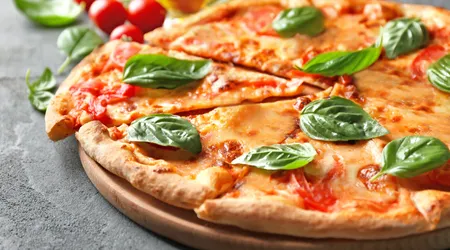Margherita Pizza: How to Make It Perfect

Margherita pizza, an icon of Italian cuisine, is much more than just a dish: it is history, tradition, and passion.
Announcements
With its bright colors—the red of the tomato, the white of the mozzarella, and the green of the basil—it represents Italy around the world, a gastronomic symbol that embodies simplicity and perfection.
But how do you prepare one? Margherita pizza authentic, capable of conquering the palate and respecting its heritage?
In this article, we'll explore every detail, from ingredients to cooking, with practical tips and techniques updated to 2025, to achieve a flawless result.
Whether you are a cooking enthusiast or an amateur pizza chef, these tips will guide you towards the Margherita pizza of your dreams. Get ready to discover the secrets of a masterpiece!
Announcements
There Margherita pizza it's not just a dish, but a story of culture and tradition.
Born in Naples in 1889, according to legend, it was created by the pizza chef Raffaele Esposito to pay homage to Queen Margherita of Savoy.
Its simplicity hides a challenge: balancing quality ingredients to enhance their flavors.
Today, with the evolution of techniques and the attention to sustainability, preparing a Margherita pizza perfect requires knowledge and care.
What are the steps to achieving a crispy crust and a soft center? Let's find out together, with a modern approach that respects tradition.
The Ingredients: The Foundation of Perfection
The quality of the ingredients is the heart of a Margherita pizzaFlour, tomato, mozzarella, and basil must be chosen carefully. Use type 0 or 00 flour, with a strength (W) between 220 and 280, for an elastic dough.
San Marzano DOP tomatoes are ideal for sauce: their natural sweetness enhances the flavor. Choose fresh fior di latte or buffalo mozzarella, well drained to avoid excess liquid.
Fresh basil, picked at the time, adds a fragrant touch. Extra virgin olive oil, preferably Italian, completes the picture. Avoid processed products: freshness is everything.
++ White pizza with rosemary and coarse salt
A significant fact: according to a 2023 study by the University of Naples, 78% of Italian consumers prefer pizzas with local ingredients.
This underlines the importance of choosing local products.
Don't underestimate the water: it must be at room temperature, with low chlorine content, to avoid compromising leavening. Quality starts in the details.

The Dough: The Art of Patience
Creating perfect dough is a ritual. Mix 1 kg of flour, 650 ml of water, 25 g of salt, and 3 g of fresh yeast. Knead for 10 minutes.
Let it rest for 8-12 hours at room temperature. The long leavening makes the Margherita pizza digestible and light. Don't speed up the process with too much yeast.
A practical example: knead the dough in the evening, cover with a damp cloth, and let it rest until morning. You'll get a soft, airy dough.
See also: Genoese focaccia: soft and tasty
The dough temperature is crucial: keep it between 24 and 26°C. Use a kitchen thermometer for accuracy. Consistency pays off.
An analogy: dough is like a fine wine; it improves with time. The longer you let it rest, the more the flavors develop. Be patient.
The Drafting: Technique and Delicacy
Rolling out dough is an art. Divide the dough into 250-280g pieces. Let them rest for 2 hours before working with them. Use your hands, never a rolling pin.
Gently press the center, leaving the thicker edges for the crust. Work on a floured surface to prevent sticking. Aim for evenness.
A common mistake is rolling the dough too thin, which can cause tearing. Keep the center of the dough about 3-4 mm thick. Practice makes perfect.
Original example: Imagine rolling out the dough as if you were caressing a delicate canvas. Every movement should be fluid, without force. Delicacy wins.
You can also try the Neapolitan technique: flip the dough in the air to spread it. It's visually appealing and functional, but requires practice. Have fun experimenting!
The Seasoning: Balance and Precision
Season a Margherita pizza requires measurement. Spread 80-100 g of San Marzano tomato sauce, leaving the edges free for the crust. Use a spoon.
Add 100-120 g of mozzarella, evenly distributed. Don't overdo it: too much mozzarella makes the pizza watery. Balance is the key to success.
Arrange 4-5 fresh basil leaves. A drizzle of extra virgin olive oil completes the dressing. Use high-quality oil, preferably organic.
Precision in toppings avoids an unbalanced pizza. Too many basil leaves, for example, can overwhelm the other flavors. Aim for harmony.
Rhetorical question: do you want a pizza that's an explosion of flavors or a blur of chaos? The answer lies in the attention to detail. Choose balance.
Cooking: The Moment of Truth
Cooking is the crucial step. A wood-fired oven at 450°C is ideal, cooking the Margherita pizza in 90 seconds. The result? A crispy crust.
At home, use an electric oven at 250°C with a baking stone. Preheat for at least 45 minutes. The stone simulates the heat of a traditional oven.
Place the pizza on the stone using a peel. Cook for 10-12 minutes, flipping it halfway through for even browning. Check the bottom.
If you have a gas oven, keep the temperature constant. Avoid opening the door: the heat must remain stable. Consistency is key.
Here's a tip: spray the oven with water before baking. The steam helps create a crispy crust. Small details make all the difference.
Tradition vs. Innovation: The Future of the Margherita
There Margherita pizza It's rooted in tradition, but 2025 brings innovation. Organic stone-ground flours are gaining popularity for their rustic flavor.
Leavening techniques are also evolving: sourdough starter is increasingly used for easier-to-digest pizza. Experimentation is permitted, but with respect.
Modern pizzerias use highly efficient electric ovens, which reduce environmental impact without sacrificing quality. Sustainability is the future.
An original example: try using spelt flour for a modern twist. It adds a nutty note, but keeps the seasoning traditional. You'll impress your guests.
Respecting tradition does not mean closing oneself to the new. Margherita pizza It's alive, it's evolving, but its heart remains unchanged. Which path will you choose?

Mistakes to Avoid: The Path to Perfection
Avoid using weak flour: the dough won't hold up to rising. Always choose a quality flour with a protein content between 10 and 121 TP3T.
Don't overload the pizza with toppings: a pizza that's too heavy becomes soft. Lightness is the essence of pizza. Margherita pizzaLess is often more.
Don't bake at low temperatures. A cold oven makes a rubbery pizza. Invest in a pizza stone if you don't have a wood-fired oven.
Ignoring the rising times is a serious mistake. Under-risen dough is heavy and indigestible. Patience is your ally.
Finally, don't use low-quality ingredients. A tasteless tomato or processed mozzarella will ruin the result. Quality doesn't happen by accident.
Table: Ideal Quantities for a Margherita Pizza (1 30cm pizza)
| Ingredient | Amount |
|---|---|
| Flour (type 0/00) | 150-160 g |
| Waterfall | 90-100 ml |
| Fresh yeast | 0.5-1 g |
| Salt | 4-5 g |
| San Marzano tomatoes | 80-100 g |
| Fior di latte mozzarella | 100-120 g |
| Fresh basil | 4-5 leaves |
| EVO oil | 1 tablespoon |
Conclusion: Your Perfect Margherita Pizza
Prepare a Margherita pizza perfetta is a journey through tradition and creativity. Every step, from kneading to baking, requires care and passion.
Choose fresh ingredients, respect the timing and experiment intelligently. Margherita pizza It's not just food, but an experience that brings people together and celebrates simplicity.
In 2025, with new techniques and a focus on sustainability, you can make every bite a tribute to Italian history. Grab the flour, fire up the oven, and create your masterpiece.
What will be your next secret ingredient?
There's nothing more satisfying than seeing a golden pizza come out of the oven, with the scent of basil filling the kitchen.
Share yours Margherita pizza with those you love, and let tradition live on through your hands. Enjoy your meal!
Frequently Asked Questions
1. Can I use packaged mozzarella for Margherita pizza?
No, fresh mozzarella (fior di latte or buffalo mozzarella) is essential for authenticity and flavor. Packaged mozzarella releases too much water.
2. How long should the dough rise?
At least 8-12 hours at room temperature for a light and easily digestible pizza. A longer leavening time (24 hours) is even better.
3. Is it possible to cook a Margherita pizza without a baking stone?
Yes, but a preheated steel or aluminum pan helps. A baking stone, however, ensures a crispier crust.
4. Can I freeze the dough?
Yes, after the first rise. Shape the dough into loaves, wrap them in plastic wrap, and freeze them. Defrost slowly in the refrigerator before using.
